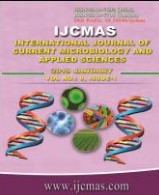


 National Academy of Agricultural Sciences (NAAS)
National Academy of Agricultural Sciences (NAAS)

|
PRINT ISSN : 2319-7692
Online ISSN : 2319-7706 Issues : 12 per year Publisher : Excellent Publishers Email : editorijcmas@gmail.com / submit@ijcmas.com Editor-in-chief: Dr.M.Prakash Index Copernicus ICV 2018: 95.39 NAAS RATING 2020: 5.38 |
A field investigation was carried out during kharif and rabi seasons of 2013-14 and 2014-15 at Agricultural Research Station, Bheemarayanagudi to study the effect of manuring techniques on soil health, yield and economics of maize – wheat cropping system under irrigation. The results indicated that the grain and stover yield of maize (55.35 q ha-1 and 70.23 q ha-1, respectively) were significantly higher with sunnhemp as green manuring in 1:2 row proportions compared to sole maize (60 cm x 20 cm) without manuring (43.85 q ha-1 and 50.18 q ha-1, respectively) and it was found on par with sunnhemp, cowpea and dhaincha as brown manuring in 1:1 and 1: 2 row proportions in maize. The residual effect of legume species used as green and brown manuring in preceeding maize was affected significantly on succeeding wheat crop. Sunnhemp as green manuring in 1:2 row proportion registered significantly higher grain yield and straw yield of wheat (38.45 q ha-1 and 70.23 q ha-1, respectively) and it was on par with sunnhemp as brown manuring in 1:2 row proportion. The lowest grain and straw yield of wheat (18.35 q ha-1 and 36.4q ha-1, respectively) were recorded in sole maize plot (60 cm x 20 cm) without manuring in preceeding season. The maize equivalent yield of wheat and system productivity followed same trend as that of yields obtained with both the crops. Varying levels of N did not vary on the performance of wheat. However, yield of wheat was recorded in 125 % RDN. Significantly higher organic carbon and available NPK were noticed with sunnhemp as green manuring in 1:2 row proportion compared to sole maize. Higher net returns and BC ratio were recorded with sunnhemp as green manuring in 1:2 row proportion (Rs.89,476 ha-1and 2.18, respectively) followed by sunnhemp as brown manuring 1:2 row proportions (Rs. 85,820 ha-1 and 2.08, respectively). The lowest net returns and BC ratio (Rs. 45,735 ha-1 and 1.16, respectively) were recorded in sole maize (60 cm x 20 cm) - wheat sequence. The different nitrogen levels did not differ.
 |
 |
 |
 |
 |